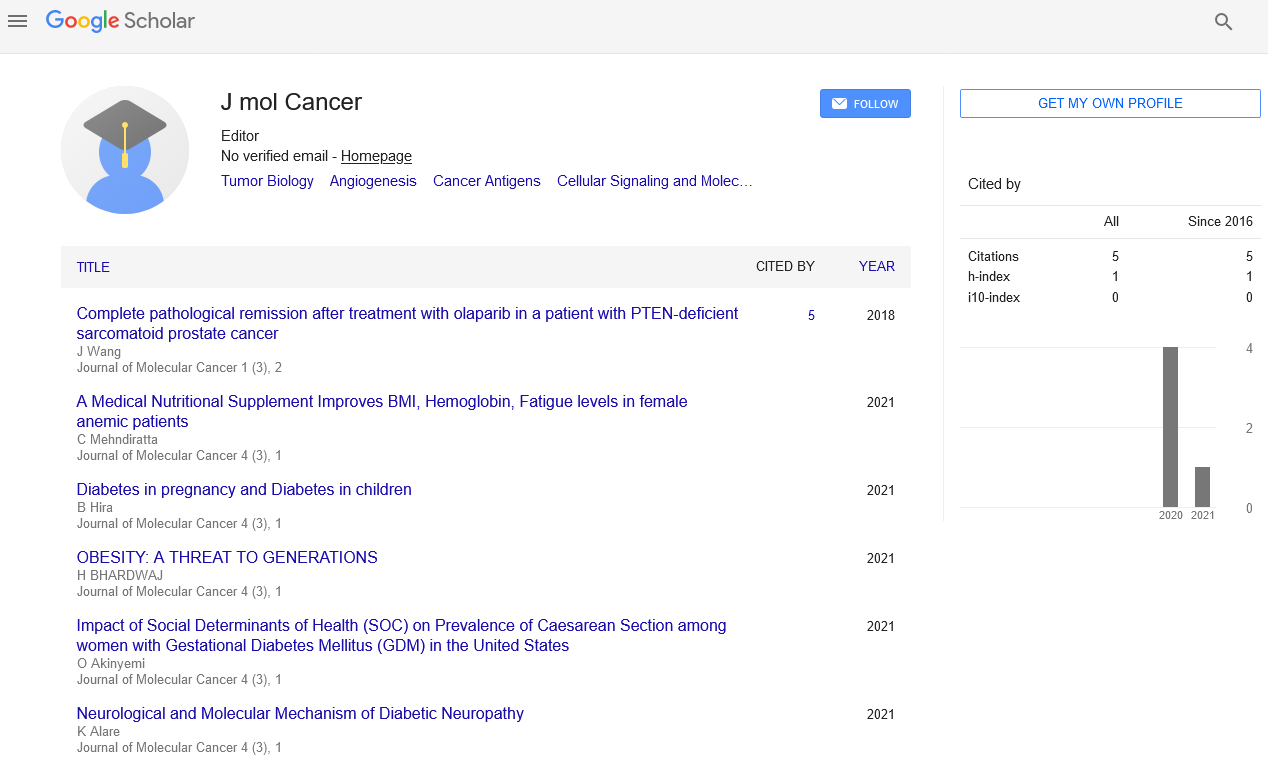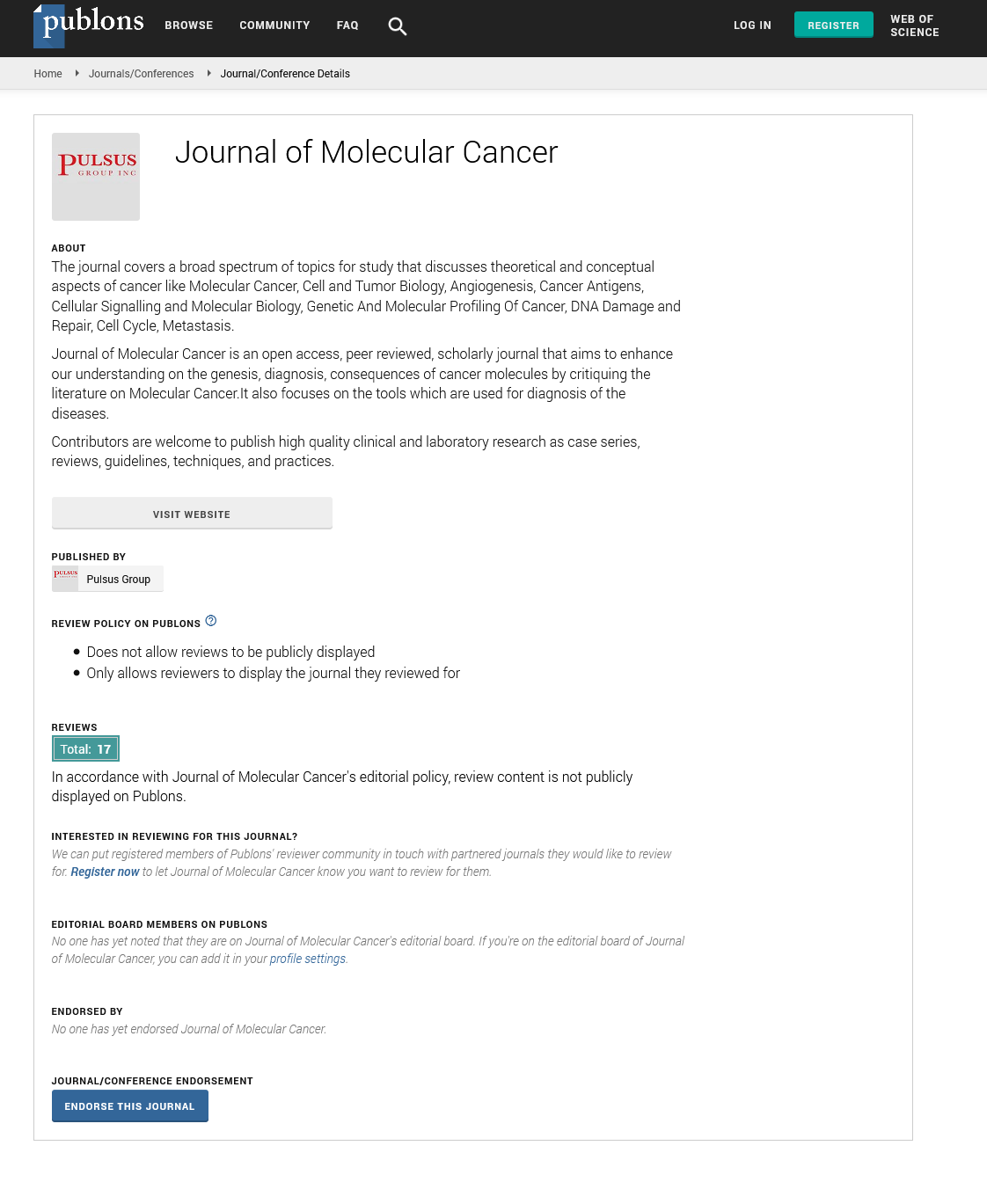Polyploidization: Overseeing and relieving disease
Received: 10-Mar-2022, Manuscript No. puljmc-22-4483; Editor assigned: 15-Mar-2022, Pre QC No. puljmc-22-4483(PQ); Accepted Date: Mar 10, 2022; Reviewed: 21-Mar-2022 QC No. puljmc-22-4483(Q); Revised: 25-Mar-2022, Manuscript No. puljmc-22-4483(R); Published: 28-Mar-2022, DOI: DOI:10.37532/puljmc.22.5(2).10-11
Citation: Janssens E. Polyploidization: overseeing and relieving disease. J Mol Cancer. 2022; 5(2):10-11.
This open-access article is distributed under the terms of the Creative Commons Attribution Non-Commercial License (CC BY-NC) (http://creativecommons.org/licenses/by-nc/4.0/), which permits reuse, distribution and reproduction of the article, provided that the original work is properly cited and the reuse is restricted to noncommercial purposes. For commercial reuse, contact reprints@pulsus.com
Abstract
Bizarrely huge malignant growth cells with unusual cores have been recorded in the disease writing beginning around 1858. For over 100 years, they have been for the most part ignored as irreversibly senescent or biting the dust cells, excessively morphologically distorted and chromatin too muddled to possibly be practical. Cell augmentation, joined by entire genome multiplying or more, is seen across creatures, frequently connected with moderation systems against ecological change, extreme pressure, or the absence of supplements. Our correlation of the systems for polyploidization in different living beings and non-changed tissues recommend that malignant growth cells draw from a saved program for their endurance, using entire genome multiplying and stopping expansion to endure pressure. These polyaneuploid malignant growth cells (PACCs) are the wellspring of remedial opposition, liable for disease repeat and, at last, disease lethality.
Key Words
Metastatic malignant growth; Polymorphous disease cells; Blastomere; Polyploidization
Introduction
Metastatic malignant growth stays superb. Metastatic malignant growth in the long run becomes impervious to all treatments and kills in excess of 10 million individuals each year worldwide. It is for the most part acknowledged that the threatening cells of a cancer develop. This implies that different hereditarily particular subclones of disease cells that began from a solitary starting malignant growth cell all exist in the tumor(s) of a solitary patient, bringing about high disease cell hereditary heterogeneity. This hereditary heterogeneity is for the most part acknowledged as the foundation of helpful opposition: a cell genealogy impervious to a class of treatment happens from arbitrary and chance hereditary transformation. We have as of late seen that almost certainly, opposition is an illustration of concurrent advancement prompting deadly disease. We accept that obstruction is interceded through biological and developmental properties of disease cells that enter a cell-state progress that incorporates polyploidization of their aneuploid genome, and leaving of the cell cycle to stop expansion, framing Polyaneuploid Malignant Growth Cells (PACCs). After pressure is taken out, PACCs go through depolyploidization to repopulate the cancer, addressing the wellspring of the "salvage impact" related with the devastating occasion of restorative mediation. We place PACCs with regards to polyploidy found in single-celled and multi-cell living beings. Differently across the tree of life, polyploidy might give an express that serves both environmental and transformative capacities.
Polyaneuploid cancer cells
Huge polymorphous disease cells have been depicted by doctors and researchers since the 1850′s. Most of the disease exploration and treatment improvement networks have ignored these cells as irreversibly senescent or bound for mitotic disaster and passing. Few spearheading researchers, including Erenpreisa, Cragg, Illidge, Liu, Walen, Rajaraman, Mirzayans and their partners, have now clarified that these cells - most normally named Polyploid Goliath Disease Cells (PGCCs), yet in addition alluded to as multinucleated monster malignant growth cells, blastomere-like malignant growth cells, osteoclast-like malignant growth cells, pleomorphic disease cells, huge disease foundational microorganisms, and Polyaneuploid Disease Cells (PACCs)-are significant go betweens of tumorigenesis, metastasis, and helpful obstruction. Practically all disease cells are aneuploid (having an unusual number of chromosomes or portions of chromosomes), and this aneuploidy is novel from growth to-cancer and malignant growth cell genealogy to-ancestry. PACCs are shaped when these aneuploid cells go through entire genome multiplying because of stress, bringing about numerous full arrangements of their disease cell heredity's aneuploid genome, i.e., polyaneuploidy. PACCs are available as a minor part of cell lines from all growth types analyzed to date. They are additionally present in patients with virtually a wide range of metastatic malignant growth. PACCs have all the earmarks of being a reversible stage in the existence pattern of deadly tumors, i.e., a day to day existence history cell-state. They structure because of disease cells' reaction to cancer microenvironment stress that gets to transformative and formative projects for polyploidy, bringing about Entire Genome Multiplying (WGD) of the aneuploid genomic supplement, expanded cell size, and expanded cell substance. PACC arrangement brings about a disease cell aggregate of reversible cell cycle capture to stay away from DNA harm, giving a transformation freethinker all-inclusive component of remedial opposition. The expanded cell size related with WGD and the respite in cell cycling considers the creation of cell hardware to adapt to pressure, expanded intracellular supplements to endure peacefulness, and expanded hereditary material to take into consideration both genome solidness temporarily and admittance to expanded heritable variety after some time.
Conclusion
PACCs address an impressive test to overseeing and relieving disease. As the wellspring of restorative obstruction, PACCs have all the earmarks of being the essential wellspring of disease's lethality. Focusing on PACCs is a troublesome undertaking since they address such a little part of the general cancer cell trouble and are really shaped because of outer pressure, including treatment. One potential technique will be to distinguish and take out or forestall the burdens that make PACCs at first structure in the essential growth microenvironment. This would forestall the inception of deadly aggregate and arrangement of metastasis starting cells. This opens the entryway for potential anticipation methodologies, conceivably by restraint of the arrangement of receptive oxygen species. Drawing from nature, effective procedures will probably require a transformative twofold tie by which a life form is compelled to take on a versatile reaction to an ecological stressor which then, at that point, makes it powerless against a second, unique stressor. For disease populaces, we imagine that the primary strike would appear as an enemy of proliferative specialist. Killing the enduring PACCs will require an original second-strike treatment that explicitly focuses on their extraordinary weaknesses. Pieces of information to these potential susceptibilities are starting to be recognized. As the projects that control polyploidization are characterized, various inhibitors of the phone cycle designated spots are clinically accessible, fit to be applied in essential habits. Aneuploidy itself and the need for fitting chromosome isolation moreover offers different helpful targets. Numerous specialists along these pathways have been grown however have fizzled in the facility since they have been given nondiscriminately to the entire populace of malignant growth cells. The enormous size and expanded cell substance of the PACCs offer potential targets auxiliary to modified metabolic pathways, e.g., lipid biosynthesis, as well as protein homeostasis and cell energetics. Quiet and treatment instigated senescence additionally offer extraordinary techniques, again in the event that applied in a twofold dilemma design. Additionally, the unusual morphology of PACCs recommends that there might be remarkable cell surface antigen profiles that can be taken advantage of for guided antigen-formation to convey a harmful payload to the cells. Focusing on PACCs should be a high need as they are the way to helpful obstruction and the seriousness of malignant growth.






